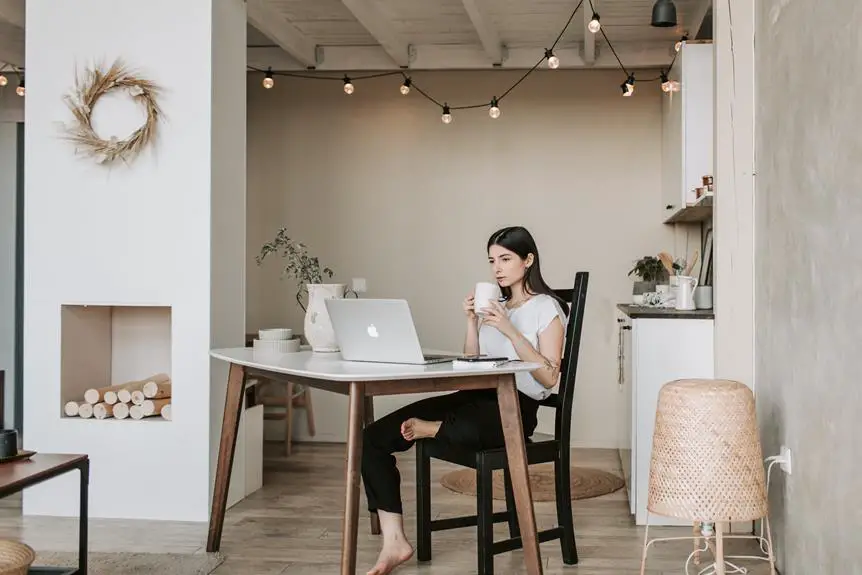Hey there, have you ever felt like your home office video calls look as dim as a candle in a cave? Well, fear not, because there's a simple solution that can truly brighten up your virtual presence.
Proper lighting can make a world of difference in how you come across during video conferences, and in this discussion, we'll explore the ins and outs of enhancing your home office video conferencing with the right lighting setup.
Whether you're a seasoned pro or new to the video call game, there's always something to learn about making a better impression in the digital realm.
So, let's shed some light on this topic and help you level up your video conferencing game.
Key Takeaways
- Proper lighting is essential for enhancing productivity and creating a comfortable work environment during video conferencing.
- Different types of lighting equipment, such as ring lights, LED panels, floor lamps, desk lamps, and window blinds/curtains, can be used to achieve optimal lighting.
- When setting up lighting, it's important to position the primary light source in front of you, avoid glare from desk lamps or ring lights, and take advantage of natural light near a window.
- Adjusting lighting for different scenarios, such as balancing natural light during daytime calls and increasing brightness in the evening, can help ensure a well-lit face and create the desired ambiance.
Importance of Proper Lighting
Proper lighting is crucial for creating a professional and engaging video conferencing environment from your home office. When it comes to video conferencing, good lighting is your best friend. Not only does it make you look good on camera, but it also has a significant impact on the overall quality of your video calls. Let's dive into the benefits of proper lighting for your home office video conferencing setup.
First and foremost, proper lighting can greatly enhance your productivity. When you can clearly see your surroundings and the people you're communicating with, it reduces eye strain and helps you stay focused. Moreover, good lighting can positively influence your mood, leading to a more pleasant and comfortable work environment. It can make you feel more energized and motivated, ultimately boosting your productivity.
In addition to the productivity benefits, proper lighting also contributes to visual comfort during video calls. Adequate lighting reduces harsh shadows and glare, making it easier for you and others to see facial expressions and body language. This not only improves the quality of communication but also fosters a more engaging and effective interaction.
Types of Lighting Equipment
Looking for the right lighting equipment to enhance your home office video conferencing setup? When it comes to video conferencing, the right lighting can make a significant difference in how you appear on camera. Let's explore the types of lighting equipment that can help you achieve the perfect lighting for your home office video conferencing needs.
| Lighting Equipment | Natural vs Artificial | Dimmable Options | Recommended Use |
|---|---|---|---|
| Ring Light | Artificial | Yes | Evenly distributed light |
| LED Panel | Artificial | Yes | Adjustable brightness levels |
| Floor Lamp | Natural | Yes | Soft, ambient lighting |
| Desk Lamp | Natural or Artificial | Yes | Task lighting |
| Window Blinds/Curtains | Natural | No | Diffusing natural light |
When it comes to lighting equipment, you have the option of using natural or artificial light sources. Natural lighting from windows can provide a soft, diffused light, while artificial lighting like LED panels and ring lights offer consistent and adjustable illumination. Many lighting options also come with dimmable features, allowing you to adjust the brightness according to your preferences and the time of day.
Understanding the different types of lighting equipment and their features can help you create a well-lit and professional-looking home office video conferencing setup. Whether you choose natural or artificial lighting, having dimmable options can give you the flexibility to adapt to various lighting conditions and achieve the perfect look for your video calls.
Setting Up Your Lighting
To set up your lighting for home office video conferencing, consider positioning your primary light source in front of you to ensure even illumination on camera. This will help prevent harsh shadows on your face and provide a more flattering look. If you're using a desk lamp or a ring light, place it behind your computer or camera at eye level. Adjusting angles is crucial to avoid glare and ensure a well-lit appearance.
Furthermore, take advantage of natural light sources whenever possible. Position your desk or workspace near a window to benefit from natural light. However, be mindful of the position of the sun to avoid glare or uneven lighting during different times of the day. You can also use sheer curtains or blinds to diffuse harsh sunlight and create a softer, more flattering light.
If you're unable to rely on natural light, consider investing in additional lighting equipment such as softbox lights or LED panels. These can be adjusted to provide the right amount of illumination and can be positioned strategically to enhance your on-camera appearance.
Adjusting Lighting for Different Scenarios
If your video conferencing setup varies based on the time of day or specific scenarios, you'll need to be mindful of how to adjust your lighting to maintain a consistent and flattering appearance on camera. When it comes to adjusting lighting for different scenarios, there are a few key considerations to keep in mind:
- Adjusting Brightness
- Daytime Video Calls: If you have natural light streaming into your workspace during the day, you may need to adjust the brightness of your artificial lighting to balance out any harsh shadows or overexposure caused by the sun.
- Evening or Night Calls: In the evening or at night, you might need to increase the brightness of your lighting to ensure that your face is well-lit and clearly visible to the participants on the call.
- Color Temperature Options
- Warm Light (2700K-3000K): For a cozy and relaxed atmosphere, consider using warmer color temperature options, especially for casual or informal video conferences.
- Cool Light (3500K-4100K): If you want to create a professional and alert ambiance, cooler color temperature options can help achieve a clean and bright look for your video conferencing setup.
Tips for Optimizing Video Call Lighting
To optimize your video call lighting, consider the following tips:
- Placement of lights: Make sure to position your lights in a way that avoids shadows and ensures your face is well-lit.
- Temperature of light: Aim for a natural and flattering look by choosing a light temperature that is not too harsh.
- Glare from windows or overhead lights: Be mindful of any glare that may be caused by windows or overhead lights, as it can be distracting and affect the quality of your video.
Lighting Placement
For optimal video call lighting, consider placing your light source in front of you at eye level to minimize shadows and create a well-lit, professional appearance.
When setting up your lighting, keep in mind the following tips:
- Lighting Angles
- Position your light source at a 45-degree angle to your face to minimize harsh shadows and create a flattering, even light.
- Avoid placing the light directly above or behind you, as it can create unflattering shadows and glare on your screen.
Light Temperature
Consider adjusting the light temperature to achieve a natural and flattering appearance during your video calls.
Color temperature refers to the warmth or coolness of light, and it can greatly impact how you appear on camera.
Natural light is ideal, so if possible, position your desk near a window. However, if natural light is limited, artificial lighting with adjustable color temperature and dimming features can be a great alternative.
Aim for a color temperature in the range of 4500K to 5500K, as it closely resembles natural daylight and can provide a fresh and vibrant look.
Avoid lighting that's too warm (yellowish) or too cool (bluish), as they can distort your appearance.
Avoid Glare
Minimize glare by positioning your light sources to avoid direct reflections on your screen during video calls. To achieve this, consider the following tips:
- Adjust Light Placement:
- Place your light sources behind your camera or off to the side to avoid reflections on your screen.
- Use diffused lighting to minimize harsh glare and shadows.
Conclusion and Next Steps
As you reflect on the information presented, consider how you can effectively implement these lighting techniques in your home office video conferencing setup. The next steps involve taking action to improve your home office lighting for video conferencing.
You can start by assessing your current lighting setup and identifying areas for future improvements. Look into upgrading your lighting fixtures to ones that offer better color rendering and adjustable brightness. Consider adding ambient lighting to reduce harsh shadows and create a more flattering look on camera. Additionally, integrating task lighting can help illuminate specific work areas without causing glare or discomfort.
In the future, keep an eye out for advancements in smart lighting technology that can be integrated seamlessly with video conferencing setups. These technologies can offer features such as color temperature adjustment, automated brightness control, and even motion-sensing capabilities. Furthermore, stay updated on best practices for lighting in video conferencing as these guidelines continue to evolve with technological innovations.
To take the next steps, create a plan for implementing these improvements in your home office. This could involve setting a budget for lighting upgrades, researching the latest lighting products, and scheduling time for installation and setup. By actively considering these next steps, you can ensure that your home office video conferencing setup benefits from optimal lighting conditions, enhancing your overall video conferencing experience.
Frequently Asked Questions
What Are Some Common Mistakes People Make When Setting up Their Home Office Lighting for Video Conferencing?
When setting up your home office lighting for video conferencing, avoid common mistakes like improper positioning and harsh lighting color. Prevent glare by positioning your light sources strategically, and use soft, diffused lighting for a professional look.
Are There Any Specific Color Temperatures or Brightness Levels That Are Recommended for Video Conferencing Lighting?
For video conferencing lighting, aim for color temperature around 5000K to 6500K and a brightness level that's not too harsh. Position your lights to avoid shadows, integrate natural light, and consider color correction for better results.
How Can I Ensure That My Lighting Setup Is Not Causing Glare or Shadows on My Face During Video Calls?
To avoid reflections and minimize shadows on your face during video calls, position your lighting in front of you and at eye level. Use a ring light or softbox to evenly illuminate your face and prevent glare or harsh shadows.
What Are Some Inexpensive Alternatives to Professional Lighting Equipment That Can Still Improve the Quality of My Video Conferencing Setup?
You can improve your video conferencing setup with some DIY lighting. Try using inexpensive options like desk lamps, LED strips, or even white bedsheets to diffuse natural light. These alternatives can significantly enhance your video quality.
Are There Any Specific Tips for Adjusting Lighting for Different Types of Video Calls, Such as Interviews, Presentations, or Casual Meetings?
So when it comes to lighting for different types of video calls, you can nail those interviews with soft, directional light. For presentations, try to illuminate your background decor. And for casual meetings, create a cozy ambiance.




